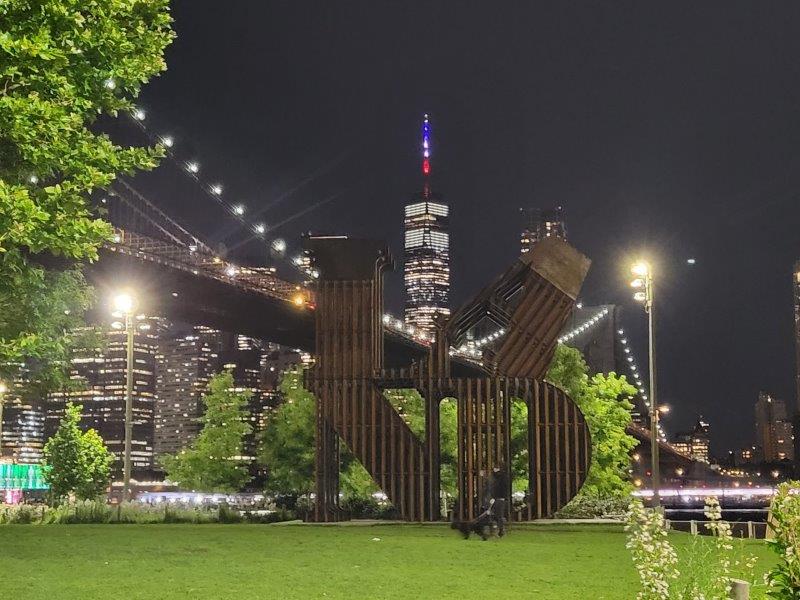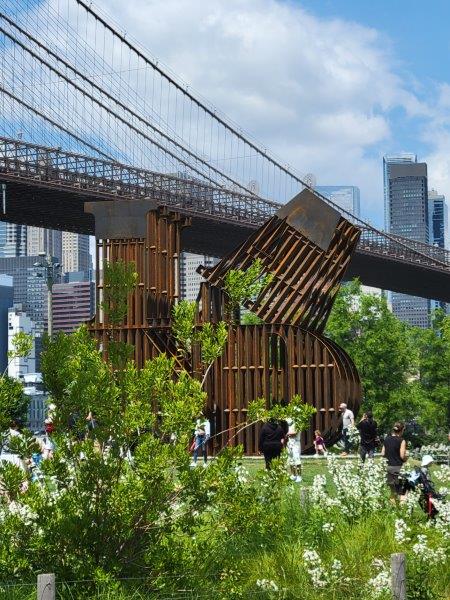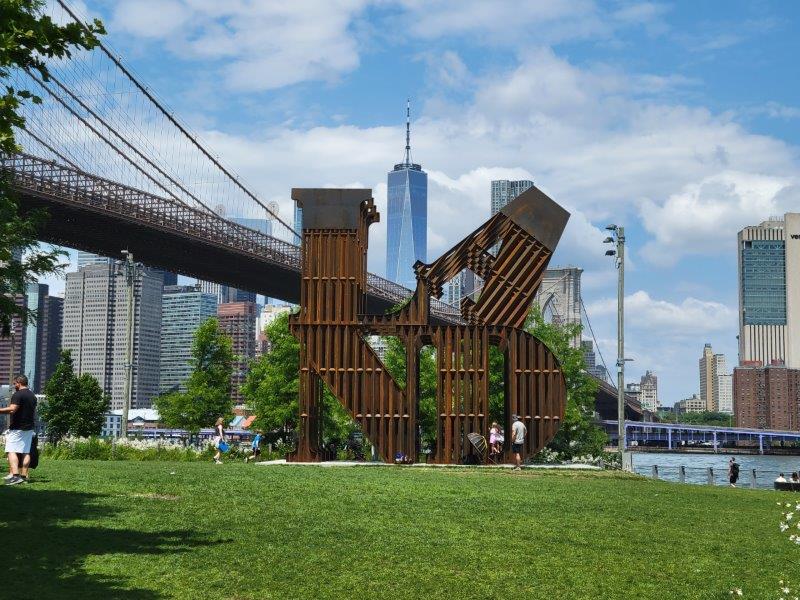The Land Sculpture by Nicholas Galanin at the Empire Fulton Ferry Lawn in Brooklyn Bridge Park is a stunning addition to New York City’s landscape. Titled “In every language there is Land / En cada lengua hay una Tierra,” the sculpture is made of steel tubing that spells out the word “LAND,” in the same style as Robert Indiana’s iconic “LOVE” sculpture. I have read about it extensively online, but to experience it juxtaposed against the Brooklyn Bridge, and with a backdrop of the Freedom Tower, was even more impactful in person, especially given all the history that the sculpture was inspired by and is a reflection of.
What makes Galanin’s sculpture even more relevant, especially when spelling out Land, is that it is made using the same materials as the U.S.-Mexico border wall, and stands 30 feet tall, which is the same height as the US-Mexico border wall. It inspires a dialogue around the concept of land, ownership, and borders, and Galanin, has said that his work “holds a mirror to one’s perspective,” and encourages viewers to think critically about the ways in which land is treated and divided.
The Land sculpture by Nicholas Galanin is a powerful work of public art that forces viewers to confront the complex issues surrounding land and borders, and its use of materials and symbolism add depth and meaning to the piece, making it a thought-provoking and impactful addition to Brooklyn Bridge Park.

Table of Contents
Land Sculpture by Nicholas Galanin
Overview
The Land sculpture by Nicholas Galanin is a 30-foot-tall sculpture made of steel tubing that spells out the word “LAND.” The sculpture spells out the word “LAND” in all caps using steel tubing in the style of Robert Indiana’s 1966 sculpture, LOVE. Commissioned by the Public Art Fund, it is located at the Empire Fulton Ferry Lawn in Brooklyn Bridge Park, and is an amazing addition to New York’s public art landscape. The sculpture was created using the same steel material that was used to construct the U.S.-Mexico border wall, and is the same height as well. The upper letters even have the anti-climbing plate that is on the actual wall.
Galanin is a member of the Sitka tribe of Alaska (Sitka: Lingit and Unangax), and the sculpture’s meaning and symbolism are rooted in Galanin’s Indigenous heritage. As a Tlingit and Unangax artist, Galanin’s work often explores themes of identity, culture, and the effects of colonization on Indigenous peoples. The “LAND” sculpture is no exception, as it alludes to borders and the ways in which they divide people and land.
Design and Construction
The Land sculpture was designed and constructed by Nicholas Galanin, an indigenous artist from Sitka Tribe of Alaska. The sculpture is made of corten steel and weighs 34,000 pounds. The steel tubing was cut and welded to form the letters that spell out the word “LAND.”
The sculpture is made of Corten steel, a weathered steel that is designed to rust and create a protective layer, which is the same material as the U.S.-Mexico border wall. It stands 30 feet tall, which is the same height as the US-Mexico border wall, and the upper letters even have the anti-climb plates as the actual border wall.

Meaning and Symbolism
The Land sculpture by Nicholas Galanin is a reflection on the impact of borders and walls on communities and their relationships with land. The artist’s intention is to force a dialogue around land and borders, and the title of the sculpture, In every language there is Land / En cada lengua hay una Tierra, is a reflection of the two languages imposed in North America since colonization.
The sculpture is designed to be viewed from different angles and perspectives, looking like an abstract work of art as it is viewed from some angles, and reflecting LAND viewed from the other perspective as you move to the other side.
The sculpture’s use of Corten steel, a weathered steel that is designed to rust and create a protective layer, adds to its symbolism. The rusted appearance of the steel evokes a sense of history and timelessness, as if the sculpture has been standing for centuries. It also symbolizes the resilience of Indigenous peoples and their ability to withstand the effects of colonization and continue to thrive.
The Land sculpture is a commentary on the history of colonization and the legacy of colonial regimes that have imposed borders and walls on indigenous communities, challenging the concept of ownership and the barriers to love that are created by walls and borders.

Public Art and Community
The Land sculpture is a part of the Public Art Fund’s free exhibitions and programs that are accessible to the public by being placed in open spaces and becoming part of the NYC landscape. The sculpture is a reflection on the impact of walls and borders on communities and their relationships with land. The sculpture invites the public to think about the concept of borders and the impact they have on our perception of land.
The Land sculpture by Nicholas Galanin is a powerful reflection on the impact of borders and walls on communities and their relationships with land, and challenges us to think about the impact of political decisions on that which sustains us all – the Land that we live on.
The Land sculpture influences viewers to confront issues of borders, land, and indigenous cultures, and is a testament to the artist’s skill and creativity and the power of public art to inspire and engage communities.

About Nicholas Galanin
Nicholas Galanin is a Tlingit and Unangax artist born in Sitka, Alaska. He is known for his thought-provoking works that challenge the colonialist narratives and highlight the issues faced by indigenous communities. Galanin’s artworks span across various mediums, including sculpture, installation, photography, and music.
Nicholas Galanin’s artistic practice is deeply rooted in his connection to the land, and his work actively engages with contemporary culture from his unique perspective. By embedding incisive observation into his creations, Galanin explores the intersections of culture and concept through various artistic mediums such as form, image, and sound. His works serve as vessels of knowledge, culture, and technology, embodying critical thought and carrying inherent political, generous, unflinching, and poetic qualities.
Galanin’s artistic endeavors encompass the past, present, and future, as he seeks to expose intentionally obscured collective memory and dismantle barriers to the acquisition of knowledge. In doing so, he critiques the commodification of culture while simultaneously contributing to the continuum of Tlingit art, honoring and expanding upon its rich legacy. Galanin employs materials and processes that expand the dialogue surrounding Indigenous artistic production and examines how culture can be carried forward in meaningful ways.
Recognized for his talent and contributions, Galanin’s work can be found in numerous public and private collections around the world. His exhibitions have garnered international attention, allowing his thought-provoking creations to reach diverse audiences. Galanin’s artistic journey includes apprenticeships with master carvers, as well as the completion of a BFA at London Guildhall University and an MFA at Massey University. Currently, he resides in Sitka, Alaska, where he lives and works alongside his family.
Galanin’s latest work, “In every language there is Land / En cada lengua hay una Tierra,” is a towering sculpture that stands at the same height as the U.S.-Mexico border wall. The sculpture spells out the word “LAND” using the same materials as the border wall, including Corten steel. The artwork is currently on display at the Empire Fulton Ferry Lawn in Brooklyn Bridge Park, thanks to the Public Art Fund.




